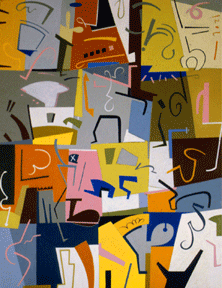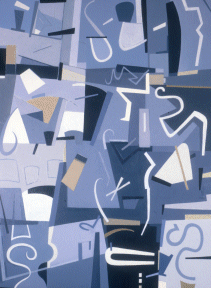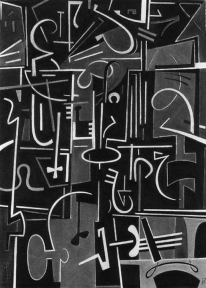| |
The Stanzas
By James
Zingarelli
I've
been reading some Aquinas on aesthetics, particularly
focusing on his concept of wholeness which he ties to
form, harmony, proportion, and order. In Umberto Eco's
tome, The Aesthetics of Thomas Aquinas, he writes
that for Aquinas "everything he says about beauty
indicates that it is grounded in form, and that if an
object is to be experienced as beautiful it must be
considered from the point of view of its formal cause,
and that beauty grounded in form, means "that it is
grounded in the concrete substantiality of things." For
Aquinas, virtue, health, and even God himself carried
this definitive harmony or "form" and interacted and
integrated with "the substantiality of things" most
evidenced in the incarnation itself.
With this series of paintings dealing with issues of
form and wholeness (the series continues) I'm hoping to
connect various idioms of language, particularly through
the use of lyric units that are simultaneously poetic,
musical, architectonic, and archeological in nature.
The Stanzas
The company of individuals have
somersault contests that land them in their neighbors’
yard. You can walk downstairs or use the fire-pole.
There are other rooms behind these: after all, it’s a
big family. This does not account for the periodic
visitor who doesn’t always use the door. Uncle Orr would
just as soon climb through the window you’ve left open.
Mike the detective drops in, literally, as if having
just escaped another suite. We live in communion, like
it or not and whether your Zen retreat lasted for six
days or six months, you must return to these zigzag
rhythms we rarely embrace, but reluctantly accept. Can I
embrace those rhythms? Is there communion here for me as
well?
Stanza is the Italian word for “room”. Every painting,
therefore, is kind of large room or house of many rooms,
a cut-away of what is occurring in each room and each
rooms takes on it’s own unique character or one might
say it is filled with characters and the events or
narratives particular to that room. A stanza is also a
block of words or phrases as in a poem, and it is also
one of a series of lyrics in a song. As with all
language these are the parts of some greater whole. Some
of the mark making may allude to glyphs and ciphers,
images or parts of images, figurative references and
narrative cycles. They are all marks that are immanently
human marks, marks made by a whole man: body, mind, and
spirit.
Each work presses at the edges of a defined structure,
the way a poet might work within the structure of a
sonnet, sestina, or pantoum. Still, the drawn or
“pulled” mark is dominant and these lines and colors are
the organizing principles within each. These grids of
“events” bump and draw into one another where enjambment
is right at home. There are doors and windows to climb
through and yes, in that traditional Renaissance idea
too, the framing of the action has been purposefully
designed into a balance which, I must tell you,
absolutely refuses to remain entirely within its own
boundaries but will elude the box, traverse to the next,
and make conversation with adjacent neighbors. I want to
have the formal pentameter of blank verse, but the
option, the opportunity, to invest and be surprised by
the possibilities and variegated dialogues. I want the
formal parallelism likened to sound in both music and
poetry as with certain repetitions that reinforce the
inherent structure while also offering a dynamic which
move the eye frame by frame. I want a playful
improvisation that keeps my attention in the making of
the work keeping monotony at arm’s length, that is, as
one friend l put it, “not hit the pattern fully”.
In these stanzas may you find, generosity, hospitality,
and music for your soul.
James Zingarelli
Gordon College
Barrington Center for the Arts
255 Grapevine Road
Wenham, Massachusetts 01984
(978) 927-2300
ext
4822
jzingarelli@gordon.edu |
|

Stanza 6

Stanza 5

Stanza
9 |
|
![]()